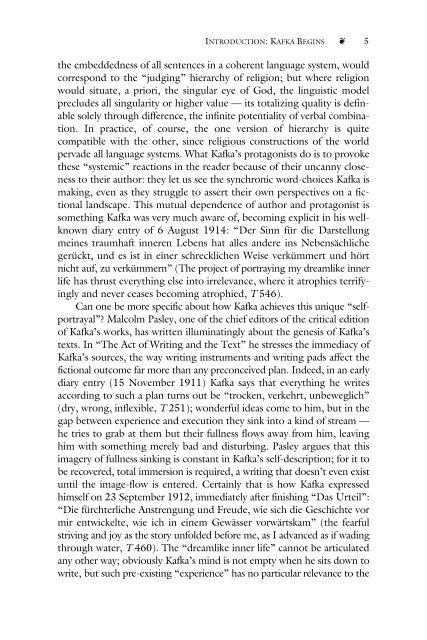Companion to the Works of Franz Kafka.pdf - tywls12ela
Companion to the Works of Franz Kafka.pdf - tywls12ela
Companion to the Works of Franz Kafka.pdf - tywls12ela
You also want an ePaper? Increase the reach of your titles
YUMPU automatically turns print PDFs into web optimized ePapers that Google loves.
INTRODUCTION: KAFKA BEGINS u 5<br />
<strong>the</strong> embeddedness <strong>of</strong> all sentences in a coherent language system, would<br />
correspond <strong>to</strong> <strong>the</strong> “judging” hierarchy <strong>of</strong> religion; but where religion<br />
would situate, a priori, <strong>the</strong> singular eye <strong>of</strong> God, <strong>the</strong> linguistic model<br />
precludes all singularity or higher value — its <strong>to</strong>talizing quality is definable<br />
solely through difference, <strong>the</strong> infinite potentiality <strong>of</strong> verbal combination.<br />
In practice, <strong>of</strong> course, <strong>the</strong> one version <strong>of</strong> hierarchy is quite<br />
compatible with <strong>the</strong> o<strong>the</strong>r, since religious constructions <strong>of</strong> <strong>the</strong> world<br />
pervade all language systems. What <strong>Kafka</strong>’s protagonists do is <strong>to</strong> provoke<br />
<strong>the</strong>se “systemic” reactions in <strong>the</strong> reader because <strong>of</strong> <strong>the</strong>ir uncanny closeness<br />
<strong>to</strong> <strong>the</strong>ir author: <strong>the</strong>y let us see <strong>the</strong> synchronic word-choices <strong>Kafka</strong> is<br />
making, even as <strong>the</strong>y struggle <strong>to</strong> assert <strong>the</strong>ir own perspectives on a fictional<br />
landscape. This mutual dependence <strong>of</strong> author and protagonist is<br />
something <strong>Kafka</strong> was very much aware <strong>of</strong>, becoming explicit in his wellknown<br />
diary entry <strong>of</strong> 6 August 1914: “Der Sinn für die Darstellung<br />
meines traumhaft inneren Lebens hat alles andere ins Nebensächliche<br />
gerückt, und es ist in einer schrecklichen Weise verkümmert und hört<br />
nicht auf, zu verkümmern” (The project <strong>of</strong> portraying my dreamlike inner<br />
life has thrust everything else in<strong>to</strong> irrelevance, where it atrophies terrifyingly<br />
and never ceases becoming atrophied, T 546).<br />
Can one be more specific about how <strong>Kafka</strong> achieves this unique “selfportrayal”?<br />
Malcolm Pasley, one <strong>of</strong> <strong>the</strong> chief edi<strong>to</strong>rs <strong>of</strong> <strong>the</strong> critical edition<br />
<strong>of</strong> <strong>Kafka</strong>’s works, has written illuminatingly about <strong>the</strong> genesis <strong>of</strong> <strong>Kafka</strong>’s<br />
texts. In “The Act <strong>of</strong> Writing and <strong>the</strong> Text” he stresses <strong>the</strong> immediacy <strong>of</strong><br />
<strong>Kafka</strong>’s sources, <strong>the</strong> way writing instruments and writing pads affect <strong>the</strong><br />
fictional outcome far more than any preconceived plan. Indeed, in an early<br />
diary entry (15 November 1911) <strong>Kafka</strong> says that everything he writes<br />
according <strong>to</strong> such a plan turns out be “trocken, verkehrt, unbeweglich”<br />
(dry, wrong, inflexible, T 251); wonderful ideas come <strong>to</strong> him, but in <strong>the</strong><br />
gap between experience and execution <strong>the</strong>y sink in<strong>to</strong> a kind <strong>of</strong> stream —<br />
he tries <strong>to</strong> grab at <strong>the</strong>m but <strong>the</strong>ir fullness flows away from him, leaving<br />
him with something merely bad and disturbing. Pasley argues that this<br />
imagery <strong>of</strong> fullness sinking is constant in <strong>Kafka</strong>’s self-description; for it <strong>to</strong><br />
be recovered, <strong>to</strong>tal immersion is required, a writing that doesn’t even exist<br />
until <strong>the</strong> image-flow is entered. Certainly that is how <strong>Kafka</strong> expressed<br />
himself on 23 September 1912, immediately after finishing “Das Urteil”:<br />
“Die fürchterliche Anstrengung und Freude, wie sich die Geschichte vor<br />
mir entwickelte, wie ich in einem Gewässer vorwärtskam” (<strong>the</strong> fearful<br />
striving and joy as <strong>the</strong> s<strong>to</strong>ry unfolded before me, as I advanced as if wading<br />
through water, T 460). The “dreamlike inner life” cannot be articulated<br />
any o<strong>the</strong>r way; obviously <strong>Kafka</strong>’s mind is not empty when he sits down <strong>to</strong><br />
write, but such pre-existing “experience” has no particular relevance <strong>to</strong> <strong>the</strong>


